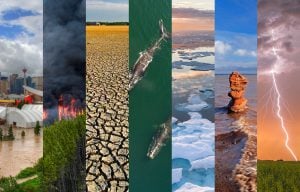When NASA says that more than 97 per cent of actively publishing climate scientists agree that the warming trends of the past century are “extremely likely due to human activities,” it seems pointless to take a contrary position.
Still, that doesn’t stop many from doing so. Take the 56 per cent of American Congressional Republicans that reject the science behind climate change, for instance. Or the Ottawa-based International Climate Science Coalition, which “encourages assisting vulnerable peoples to adapt to climate variability and continuing scientific research into the causes and impacts of climate change.” Or — and perhaps most unusually — a French geophysicist named Vincent Courtillot, who along with his colleagues in 2006 published a controversial paper linking global warming to fluctuations in Earth’s magnetic field. The paper summarized a number of studies indicating possible correlations between climate and the Earth’s magnetic field.
One theory reviewed by Courtillot and his colleagues, for example, references the effects of solar wind. Solar wind is a continuous flow of particles emitted by the sun. Courtillot et al. call these particles “a significant driver of changes” for climate and the behaviour of Earth’s magnetic field.
If the radiation carried by solar wind was allowed to reach the surface, it would cause serious damage to life on Earth. Earth’s magnetic field, thankfully, acts as a kind of shield and prevents these rays from frying the planet.
That’s not to say, however, that solar rays don’t have an effect.
According to space.com, the force of solar wind stretches Earth’s magnetic field “so that it is smooshed inward on the sun-side and stretched out on the night side.” In doing so, solar wind directly influences the shape and morphology of Earth’s magnetic field.
Solar wind is a constant force, but its various properties change with the sun’s 11-year solar cycle. Courtillot and his colleagues believe an “overall magnetic trend” emerges alongside this cycle. They are convinced, therefore, that irregular magnetic variations can be studied “after carefully removing regular daily variation.”
“If solar activity is correlated to climate over much of historical times, it might be expected that the ‘overall magnetic trend’ would correlate with the recent evolution of global temperature,” says the study. “Of course, the relation in this case does not imply a causal link from Earth’s magnetism towards climate, but from the sun to both climate and magnetic changes.”
According to Courtillot, Earth’s magnetic field also regulates “incoming fluxes of cosmic rays” — rays he and other scientists claim influence changes in cloud cover and albedo (the proportion of light or radiation reflected back into space by the Earth’s surface). Fewer clouds equal a warmer climate, as clouds reflect heat from the sun back into space.
This hypothesis hinges on the work of Henrik Svensmark, a Danish astrophysicist and weather scientist who argues the planet is in the midst of a natural period of low cloud cover caused by a decrease in the number of cosmic rays entering the atmosphere.
Courtillot and his colleagues suspect recently proposed phenomena known as archeomagnetic jerks — defined by the study as “fairly abrupt (∼100 yr long) geomagnetic field variations found at irregular intervals over the past few millennia” — also play a part in influencing Earth’s climate. According to Courtillot et al., archeomagnetic jerks look as though they correlate with historically significant climatic events in the eastern North Atlantic.
Not everyone, however, is convinced by the findings summarized by Courtillot and his team.
In a follow-up article published in 2007, Edouard Bard and Gilles Delaygue, two professors at the Collège de France in Paris, denounced the “hypothetical link” between geomagnetism, cosmic rays and cloud cover, saying it has “no convincing support.” Instead, Bard and Delaygue, like many other scientists, attribute climate change to a “combination of natural (Sun and volcanoes) and anthropogenic forcings that became significant during the second half of the century.”
At the end of his paper, Courtillot admits “intensive data acquisition is required to further probe indications that the Earth’s and sun’s magnetic fields may have significant bearing on climate change at certain time scales.”
*with files from Harry Wilson






